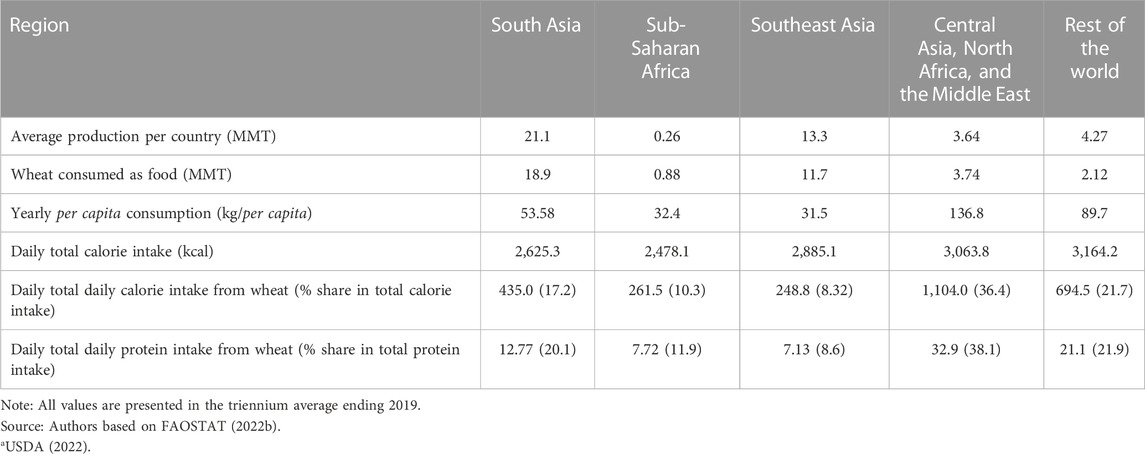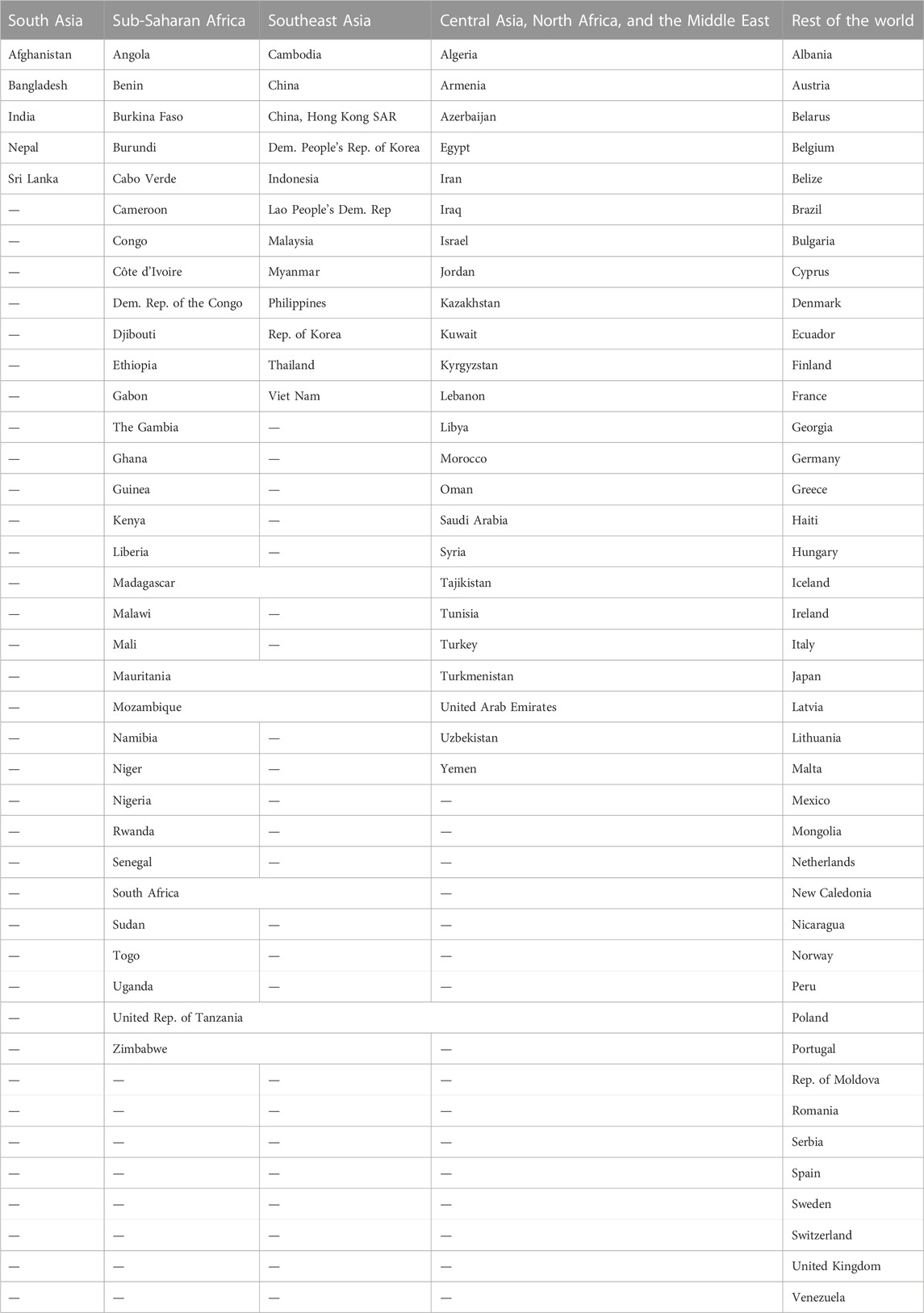- 1Agricultural Economics and Agribusiness Department, University of Arkansas, Fayetteville, AR, United States
- 2Global Wheat Program (GWP), International Maize and Wheat Improvement Center (CIMMYT), Texcoco, México
Introduction: This study examines the potential impacts of Russia-Ukraine armed conflict on the consumption and trade of wheat and wheat food security. Russia and Ukraine jointly supply more than one-fourth of total wheat in the international market. Because of the ongoing armed conflict between Russia and Ukraine, wheat export from these two countries is heavily disrupted. Applying an ex-ante impact assessment procedure, this study examines the potential impacts of Russia-Ukraine armed conflict on the consumption and trade of wheat and wheat food security.
Methods: This study considered 115 countries and grouped them based on their geographic location. The sampled countries are grouped as: South Asia, Sub-Saharan Africa, Southeast Asia, Central Asia, North Africa, Middle East, and rest of the world. Simulation results are presented by the geographic location of the sampled countries. To assess the potential impacts of the ongoing Ukraine-Russia armed conflict on wheat food security in the sampled countries, this study mainly sourced data from FAOSTAT. This study first calculates the share of wheat consumption imported from Russia and Ukraine. Then, this study calculates the daily total calorie and protein intake exclusively from the imported wheat from Russia and Ukraine in the sampled countries by their groups. It is found that 1 kg of wheat provides roughly 2,839–2,965 kilocalories (kcal) of energy, and between 81 and 88 g (gm) of protein, in the sampled countries. Using the conversion factors, this study assesses the impacts of a reduction of wheat exports in the global market due to the ongoing armed conflict between Russia and Ukraine applying an ex-ante assessment process. Specifically, this study assumes a 100% and 50% reduction in wheat exports by Russia and Ukraine, and then estimates its impact on daily calorie and protein intake in the sampled countries.
Results: The ex-ante simulation shows that, under the assumption of a 100% reduction of wheat exports from Russia and Ukraine and assuming alternative wheat import sources are unavailable, yearly per capita wheat consumption would be reduced by 19% in South Asia, 57% in Sub-Saharan Africa, 26% in Southeast Asia, nearly 39% in Central Asia, the Middle East and North Africa, and 27% in other areas. Consequently, daily per capita calorie intake in South Asia would fall by more than 3%, in Sub-Saharan Africa by more than 6%, in Southeast Asia by 2.2%, in Central Asia, the Middle East, and North Africa by 14%, and in the other countries of our study by 6.2%. A 50% reduction of wheat exports by Russia and Ukraine without substitute supplies of wheat grain would also substantially reduce wheat consumption as well as daily calorie and protein intakes from wheat, in the sampled countries.
Discussions: Malnutrition and hunger are widespread in many countries of Asia and Africa that depend on wheat and other imported cereals to meet their rising food demand. Rising wheat prices, particularly in countries that rely on imported wheat, can lead to violence and social unrest, as occurred during 2007-11. Based on the findings, to avoid hunger and supply shock related disaster in the future, this study urges to search alternative sources of wheat for the import-dependent, resource-poor countries. Eventually, as there are few alternatives to increase wheat supply other than enhancing yield gain, this study strongly suggests for steady public funding for adaptive and basic research to harness genetic gains for yield and climatic adaptation in wheat. Also, in the long run, it is necessary to explore the possibility of wheat area expansion in the suitable countries. For example, a recent study confirmed the potentiality of wheat area expansion in Argentina and Brazil. Also, there is also a possibility of expansion of wheat area in Sub-Saharan African countries. Exploring opportunities for the expansion and sustainable intensification of wheat production in suitable countries can be instrumental to ensuring self-sufficiency in wheat supplies in Sub-Saharan Africa.
1 Introduction
In 2019, 8.9% of the total 7.68 billion population of the world was undernourished (FAO et al., 2020). Alarmingly, the number of undernourished people has started to increase recently (FAO et al., 2020; United Nations, 2022a; von Grebmer et al., 2021). The major drivers of undernourishment, food insecurity and hunger are climate and economic shocks, crop diseases and pests epidemics, and war and conflicts (FAO et al., 2020). Among all factors, war and conflicts are the major drivers of hunger and food insecurity in the contemporary world. For example, in 2020, globally 155 million people were acutely food insecure, of which more than 64% of them (99.1 million) were residing in 23 countries where, war and conflicts were the principal causes of food insecurity (von Grebmer et al., 2021). Since February 2022, the world has witnessed a fresh armed conflict between the Russian Federation (hereafter Russia) and Ukraine. These two countries are the major producers and exporters of many essential commodities including sunflower oil, maize and wheat, and synthetic fertilizers (FAO, 2022). Because of the ongoing armed conflict, exports of commodities from these countries are severely interrupted, which has raised concerns about the possible effects on world food security (Table 7).
Applying an ex-ante impact assessment procedure, this study examines the potential impacts of Russia-Ukraine armed conflict on the consumption and trade of wheat and wheat food security. Wheat is the most widely grown crop in the world. In TE 2019 (triennium average, 2017–19 average), total land allocation to rice was less than 164 million ha, to maize less than 198 million ha, and to wheat 217 million ha (FAOSTAT, 2022a). Millions of resource-poor smallholder farmers in Asia and Africa rely on wheat cultivation for food, livelihoods, and income. Wheat also plays a crucial role in global food and nutritional security (Dixon, 2007; Dixon et al., 2009; Shiferaw et al., 2013), being consumed as food by inhabitants of at least 180 countries in 2019. The global triennium average ending 2019 (TE-average of 2017–19) per capita wheat consumption was nearly 67 kg and wheat-based food supplies more than 18% (543 kcal) of daily per capita dietary energy intake and nearly 20% (16.4 gm) of total daily protein intake per person, worldwide (FAOSTAT, 2022a). It is projected that by 2030 the yearly per capita wheat consumption in the world will be 70 kg, and in 2050 it will be 75 kg, will be propelled by increase in population and urbanization (Mottaleb et al., 2021a). It suggests that wheat will continue to play a significant role in global food security in the future.
Importantly, many countries in the world, particularly in Asia and Africa, rely on wheat imports to meet their demand. For example, Bangladesh, Sudan, Indonesia, Nigeria, Congo, Mali Madagascar, Chad, Ghana, El Salvador, Guinea, Lesotho, Djibouti, Rwanda and Cambodia heavily rely on wheat import for meeting demand. In fact, in 2020, at least 179 countries imported wheat to meet their domestic demand (FAOSTAT, 2022b). Food security situation in many of these wheat importing countries, is already precarious.
Because of the ongoing armed conflict between Russia and Ukraine, wheat export from these two countries is heavily disrupted. In 2021, Russia produced 75.5 million metric tons (MMT) of wheat (9.7% of global production) on 27.9 million ha of land (12% of world wheat area, TE 2021), making it the third largest wheat producing country. Ukraine ranked sixth in wheat production in 2021, accounting for 33 MMT (4.3% of world production) grown on 7.1 million ha (3.3% of world wheat area) (USDA, 2022). However, Russia is the world’s number-one wheat exporting country, selling 32 MMT of wheat grain, or 16% of the world total 203 MMT, in 2021 (USDA, 2022). Ukraine was the fourth-largest exporter, accounting for 20 MMT of grain, or nearly 10% of the world total (USDA, 2022). Russia and Ukraine thus jointly supply more than a quarter of wheat in international markets. Many countries in the world heavily rely on Russia and Ukraine for wheat imports. Thus, the disruption in wheat exports from Russia and Ukraine due to the ongoing armed conflict will have devastating impacts on global food security.
There are a few opinion studies and blogs on the potential impacts of the ongoing armed conflict between Russia and Ukraine on the global food security (Abay et al., 2022; Bechdol et al., 2022; Bentley, 2022; Douglas, 2022; Sabaghi, 2022). The present study is a complete scientific study based on data and applies ex-ante impact assessment procedure to quantify the potential impacts of the disruption of wheat exports from Russia and Ukraine due the ongoing armed conflict on global wheat food security (Section 1). The rest of the study is organized as follows. Section 2 presents materials and methods; Section 3 includes temporal changes in wheat production and consumption by major regions; Section 4 presents major findings and Section 5 presents conclusions and policy implications.
2 Materials and methods
2.1 Data
This study relies on data from FAOSTAT (FAOSTAT, 2022a), a database administered by the Food and Agriculture Organization of the United Nations (FAO), as well as online data of the United States Department of Agriculture Foreign Agriculture Services (USDA-FAS) (USDA, 2022), and the United Nations “Comtrade” international trade statistics database (United Nations, 2022b).
To examine the potential impacts of a reduction in wheat exports by Russia-Ukraine on food and nutrition security of the wheat importing countries, this study considered the sampled 115 countries, their wheat imports from Russia and Ukraine in 2017–19, and wheat-related food consumption indicators such as domestic production, yield, total imports, yearly per capita, and aggregate total wheat consumption, and dietary energy intake (kcal and protein) from wheat. The name of the sampled countries can be seen in the Appendix. In this study sampled countries are grouped based on their geographic locations and the results are presented by groups.
2.2 Ex-ante impact assessment technique
To assess the potential impacts of the ongoing Ukraine-Russia armed conflict on wheat food security in the sampled countries, this study first calculates the share of wheat consumption imported from Russia and Ukraine. After that based on FAOSTAT data, this study calculates the daily total calorie and protein intake exclusively from the imported wheat from Russia and Ukraine in the sampled countries. It is found that 1 kg of wheat provides roughly 2,839–2,965 kilo calories (kcal) of energy, and between 81 and 88 gm of protein, in the sampled countries. Using the conversion factors, this study assesses the impacts of a reduction of wheat exports in the global market due to the ongoing armed conflict between Russia and Ukraine. Specifically, this study assumes a 100% and 50% reduction in wheat exports by Russia and Ukraine, and then estimates its potential impacts on daily calorie and protein intake in the sampled regions.
3 Descriptive statistics: Temporal changes in wheat production, consumption, and trade
Global wheat production has increased and expanded over the last five decades, with area growing from 206 to 216 million ha during 1961–2020, due to mainly increases in wheat areas in Asia, Africa, and Oceania and area reductions in the Americas and Europe (Table 1). In TE 1963, wheat was cultivated on 206 million ha worldwide with an average yield of 1.14 t/ha, producing more than 253 MMT of wheat grain. In TE 1963 more than 45% of the world wheat area of 93.2 million ha was in Europe, producing nearly 49% of the global harvest for this crop (Table 1). Asia has since emerged as the dominant wheat-producing region, accounting by TE 2020 for 99 million ha (nearly 46%) of global area (216.3 million ha) and 45% of the annual average 753 MMT of grain produced (Table 1).
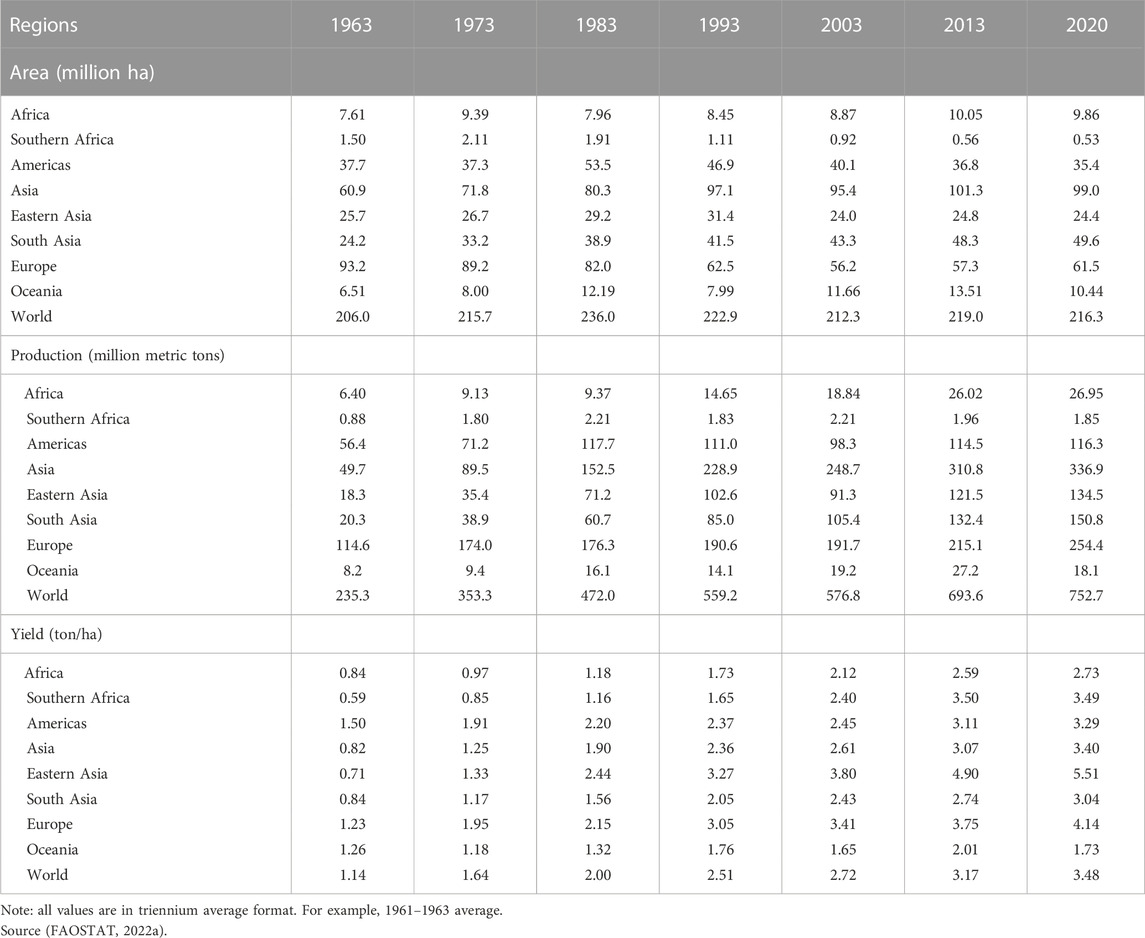
TABLE 1. Temporal changes in the wheat area (million ha) and production (million metric tons) during 1961–2020.
Notably, despite a modest global area increase of 5% during 1961–2020, global wheat production has increased by 220% (235 MMT in TE 1963 to nearly 753 MMT in TE 2020) driven by a more than 200% increase in average yield, from 1.14 t/ha in TE 1963 to 3.48 t/ha in TE 2020 (Table 1). This owes largely to the improved agronomic practices, irrigation facilities, application of fertilizers, the control of wheat diseases and pests and the development of high-yielding modern varieties.
Global average yearly wheat consumption per capita increased by 20% during 1961–2019, from slightly more than 55 kg to nearly 68 kg, due to mainly increased wheat consumption in the economically emerging countries of the Global South (Table 2), and particularly in Africa and South Asia, where the popularity of wheat-based food products has grown (Gandhi et al., 2004; Nagarajan, 2005; Mason et al., 2015; Mottaleb et al., 2018a). Annual per capita and national aggregate wheat consumption, as well as net wheat trade, have declined in Europe. Wheat consumption in Europe fell from more than 131 kg per capita yearly in TE 1963 to 112 kg in TE 2019 (Table 2). Yearly per capita wheat consumption in Oceania has declined from nearly 97 to 67 kg over the same period, but aggregate wheat consumption there rose from 1.35 to 2.75 MMT (Table 2).
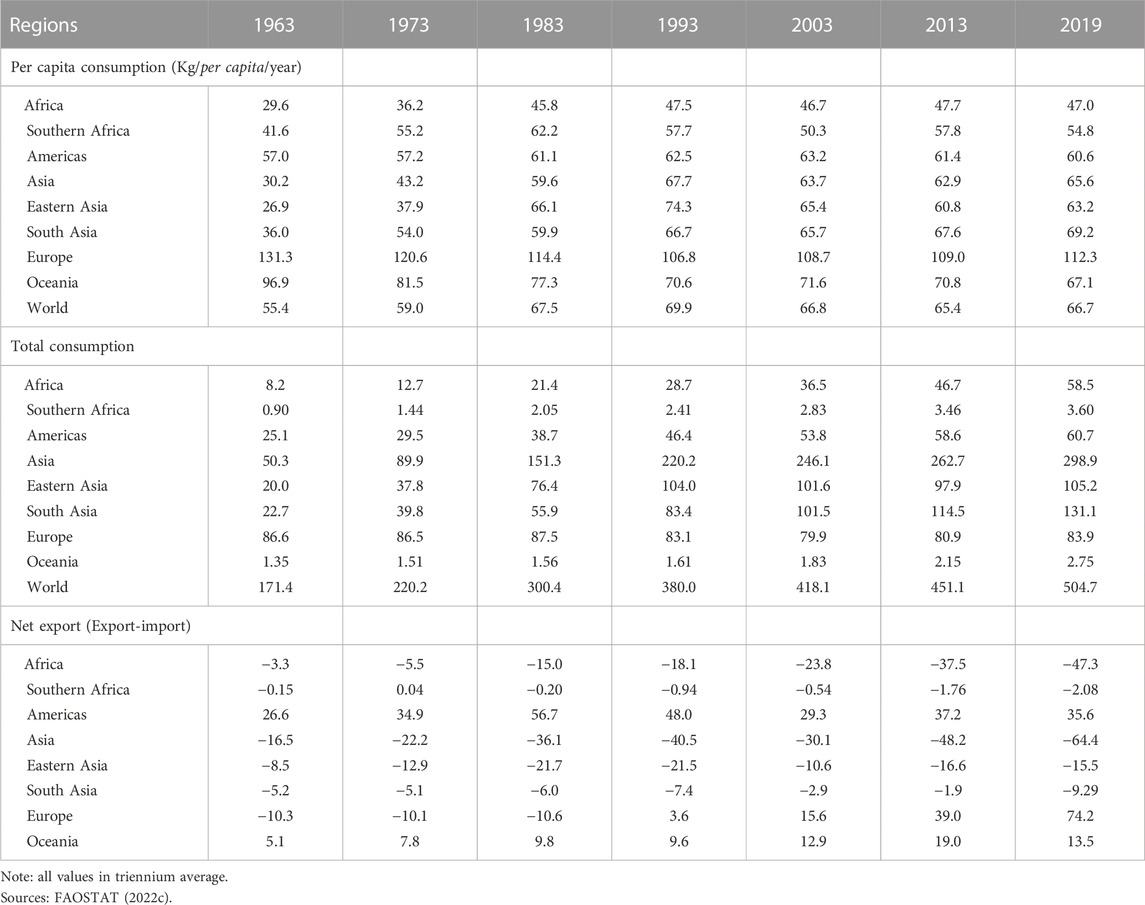
TABLE 2. Temporal changes in wheat consumption, and net exports (million metric tons) by major regions in the world.
South Asia and Sub-Saharan Africa have the world’s highest share of undernourished population (FAO et al., 2020; von Grebmer et al., 2021); 22% or nearly 250 million of the population in Sub-Saharan Africa and 13.4% or 249 million in South Asia (FAO et al., 2020).
In Africa, annual wheat consumption was less than 30 kg per capita in TE 1963 (Table 2), supplying 233 kcal of daily dietary energy per capita or 11.5% of the average daily intake per person, and 7 gm of protein, or about 13% of daily intake (FAOSTAT, 2022c). In TE 2019, wheat consumption had increased to 47 kg per capita per year, supplying more than 374 kcal of dietary energy per capita, or nearly 15% of the average daily intake, as well as more than 11 gm of protein per person, or more than 17% of the daily intake (FAOSTAT, 2022d). In South Asia in TE 1963, yearly wheat consumption was 36 kg per capita, supplying 308 kcal of dietary energy daily or more than 15% of the average daily per capita intake, and nearly 9 gm of protein, around 17% of the daily per capita intake (FAOSTAT, 2022c). In TE 2019, yearly wheat consumption in the region had increased to more than 69.2 kg per capita, supplying over 585 kcal of dietary energy per day, or nearly 23% of the average daily intake, and 16.8 gm of protein, or more than 26% of the daily intake per person (FAOSTAT, 2022d).
An examination of the net trade (export-import) status for wheat producing and consuming countries revealed that, except for the Americas, Europe, and Oceania, all other regions are net wheat importers (Table 2). Importantly, although Asia has emerged as the world’s largest wheat-producing region, it is also the top wheat importing region (Table 2). Despite significant wheat production increases since the early 1960s in Asia-South Asia in particular, and Africa, increases in per capita wheat consumption and population growth have widened the export-import gap of these regions (Table 2). China and India are the world’s largest wheat-producing and consuming countries. In TE 2019, China and India jointly cultivated more than 54 million ha, 25% of world wheat area of the world, and produced 234 MMT of wheat, accounting for nearly 31% of the world total. However, with a joint total of 2.79 billion inhabitants, or 36% of the world population (7.76 billion), both countries consume their wheat harvest, with only sporadic wheat exports by India. Currently, less than 10% (14.2 MMT) of the wheat consumed (150.6 MMT) in South Asia is imported from international markets (USDA, 2022). Regarding major international exporters of wheat, Russia and Ukraine are the top exporters (Figure 1). Of 2021/22 global wheat export, totaling 203 MMT, Russia’s share was more than 16% (33 MT) and Ukraine’s share was more than 9% (19 MMT) (Figure 1). Russia and Ukraine altogether exported nearly 26% of the total wheat in the world in 2021/22 (Figure 1).
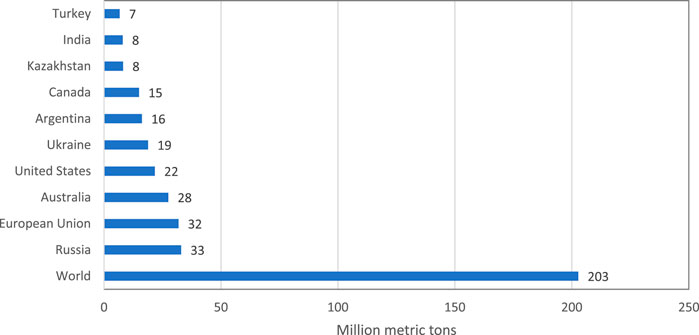
FIGURE 1. Top 10 wheat exporting countries in 2021/22. Source: Authors based on USDA (2022).
Among the major global importers, Egypt, Indonesia and China are the world’s top three wheat importing countries (Figure 2). In 2021/22, Egypt imported 12 MMT, Indonesia 11 MMT and China 10 MMT (Figure 2).
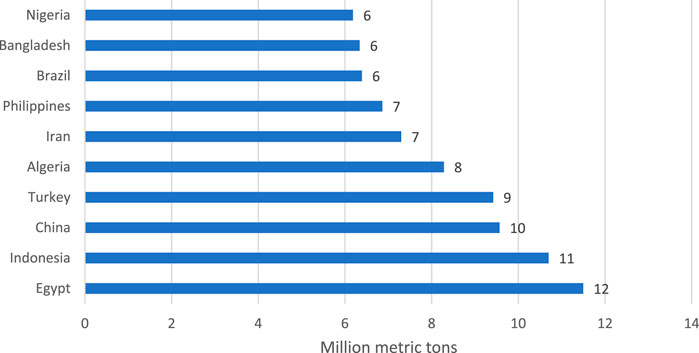
FIGURE 2. Top 10 wheat importing countries in 2021/22. Source: Authors based on USDA (2022).
However, many developing countries in Asia and Africa heavily rely on imported wheat for domestic consumption. Countries where the ratio of wheat import is more than or equal to 100% are presented in Figure 3. It shows that Oman, El Salvador, Lesotho, Rwanda, Guinea-Bissau, Uganda, Mauritania and many other countries completely rely on wheat imports for domestic consumption (Figure 3). A reduction of wheat supply in the international market due to the ongoing conflict between Russia and Ukraine can bring significant negative impacts on the food security situation of the countries, that rely completely on imported wheat to meet domestic demand.
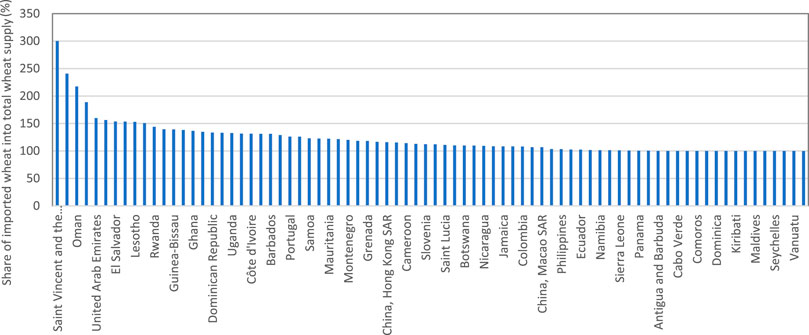
FIGURE 3. List of countries in 2019, where wheat consumption completely relies on imported wheat (imported wheat/Total domestic supply) (≥100%). Source: Authors based on FAOSTAT (2022d).
Importantly, as Russia and Ukraine jointly are the source of nearly 26% of wheat in the international export market, many countries in the world rely on wheat imports from Russia and Ukraine for meeting domestic food demand (Figure 4). Using the Harmonized Commodity Description and Coding System (HS) code for wheat and meslin (HS code: 1001), a search of Comtrade revealed that, during 2017–19, 47 countries imported wheat from both Russia and Ukraine, 42 countries imported wheat from Russia alone, and 16 countries imported wheat from Ukraine alone (United Nations, 2022b).1
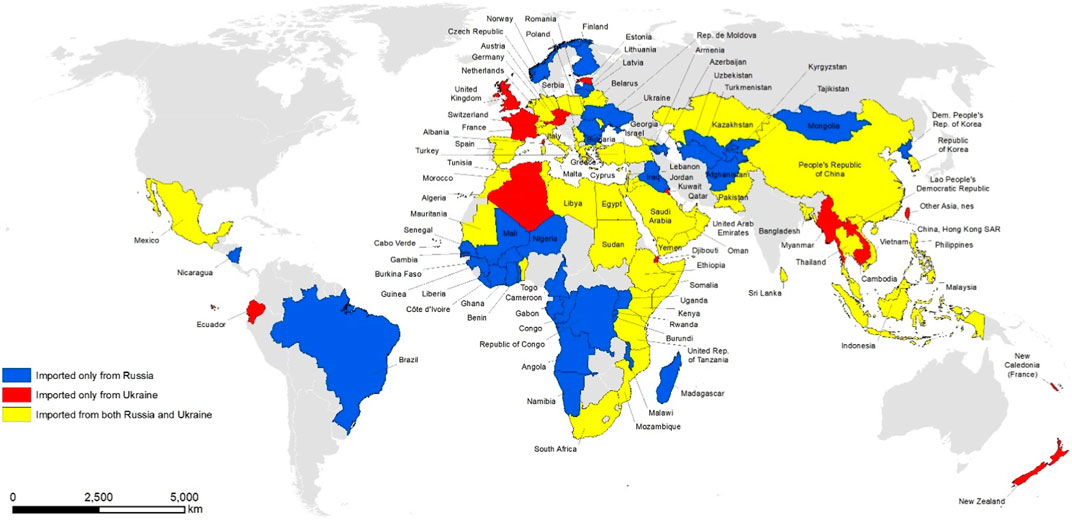
FIGURE 4. Countries that imported wheat from Russia and Ukraine in 2017–19. Source: Authors based on United Nations (2022b).
Applying an ex-ante impact assessment procedure this study specifically examines the potential impacts of a reduction of wheat exports from Russia and Ukraine, on wheat consumption and calorie and protein intake from wheat in the sampled countries.
4 Ex-ante impact assessments and discussions: major findings
The nutrition value of wheat is presented in Table 3, calculated based on FAOSTAT data. Our calculation shows that on average 1 kg of wheat provides, around 2900 kcal of dietary energy and nearly 86 gm of protein (Table 3). In assessing the impacts of the ongoing Russia-Ukraine armed conflict on wheat food security, we have used these conversion factors.
In Table 4, the wheat consumption pattern across regions is presented. Although countries in South Asia produce (21.1 MMT on average) and consume (18.9 MMT on average) more wheat than in any other region, the role of wheat as a staple food is more prominent in Central Asia, the Middle East, and North Africa, where yearly per capita wheat consumption exceeds 136 kg, supplying more than 36% of the daily total dietary energy and more than 38% of the daily total protein intake per person (Table 4). In Sub-Saharan Africa, annual average per capita wheat consumption just exceeds 32 kg, supplying over 10% of the daily dietary energy intake and 12% of protein intake, per capita (Table 4).
Many of the countries in our sample rely on wheat imports and particularly those from Russia and Ukraine. For example, a sampled South Asian country, such as Bangladesh, imported nearly 2,404 thousand MT (2.4 MMT) of wheat in TE 2019, of which nearly 1,422 thousand MT came from Russia and Ukraine and accounting for more than 59% of the country’s total during TE 2019 (Table 5). Imports from Russia and Ukraine accounted for more than 38% of the wheat imported by countries in Sub-Saharan Africa, nearly 23% of national imports in Southeast and East Asia, more than 48% of imports by countries in Central Asia, North Africa, and the Middle East, and around 7% of imports by other countries in our sample (Table 5). In 2017, sampled countries imported nearly 51 MMT of wheat from Russia and Ukraine, which increased to 52 MMT in 2018, and 60 MMT in 2019. Importantly, the share of Russia and Ukraine wheat in the total consumed in South Asian countries is 7.5%, more than 34% of that consumed in Sub-Saharan African countries, 7.4% of that consumed in Southeast Asian countries, 34% of that consumed in Central Asian, North African, and Middle Eastern countries, and nearly 7% of the wheat consumed in other countries of our sample (Table 5). The ending stock of wheat in the sampled countries shows that, on average, none of them can meet their wheat demand for a year with their current stock of wheat (Table 5). It indicates the importance of Russian and Ukraine wheat exports for food security worldwide and, particularly, for South Asia and Sub-Saharan Africa.
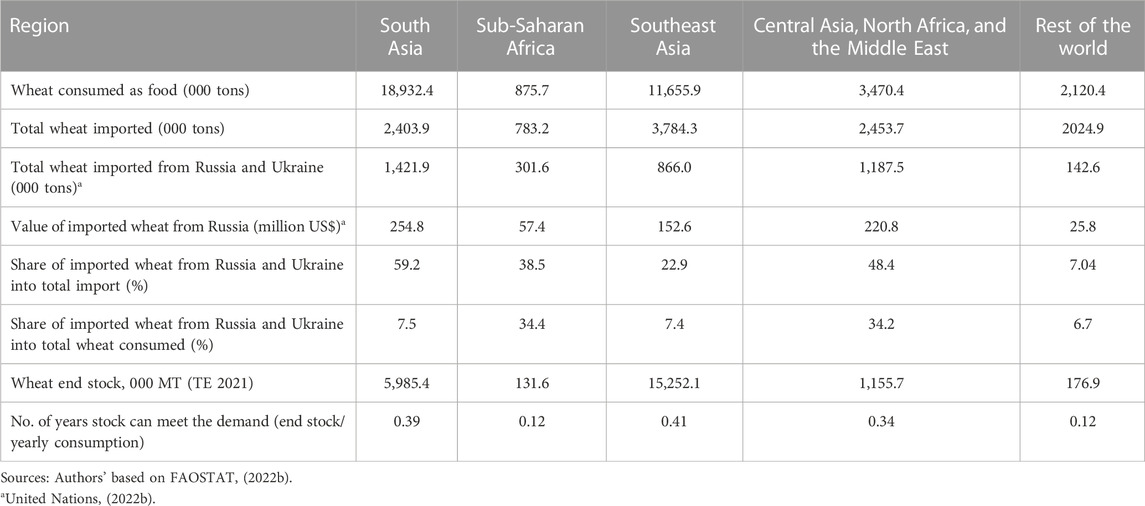
TABLE 5. Share of wheat import, and wheat import from Russia and Ukraine into total wheat consumption (000 tons) in the sampled regions.
On average, the yearly per capita consumption of imported wheat from Russia and Ukraine is more than 10 kg for the sampled South Asian countries, which is 19% of the yearly per capita wheat consumption of a sampled country in South Asia (Table 6). Yearly per capita consumption of Russian and Ukraine wheat in the Sub-Saharan Africa countries of our sample is more than 18 kg, or 57%, of the wheat they consume. Wheat imported from Russia and Ukraine constitutes 53 kg, or 39% of that consumed per capita each year in the Central Asian, Middle Eastern and North African countries in our sample. It is more than 24 kg, or 27% of yearly per capita wheat consumed in the other countries of our study (Table 6).
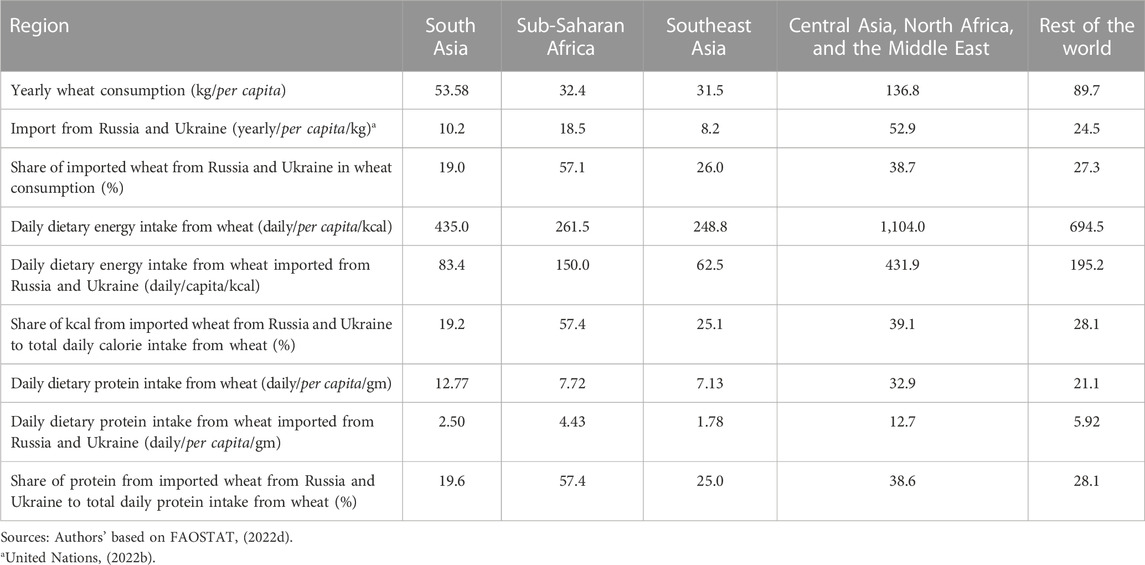
TABLE 6. Importance of imported wheat from Russia and Ukraine in food and nutrition security of the sampled regions.
The average daily per capita dietary energy intake from wheat in a sampled South Asian country, such as Nepal is 435 kcal, 83.4 kcal (19.2%) of which is provided by wheat imported from Russia and Ukraine (Table 6). Of total daily dietary energy intakes in the countries of this study, the share provided by Russian and Ukraine wheat is more than 57% for Sub-Saharan African countries and more than 39% for Central Asian, Middle Eastern, and North African countries (Table 6). The imported wheat from Russia and Ukraine also contributes significantly to daily dietary protein intake in those countries. For example, in a sampled country in East and Southeast Asia, 1.78 gm, or 25% of the total 7.13 gm of average daily protein per capita from wheat, is provide by that imported from Russia and Ukraine (Table 6).
In Tables 7 and 8, two “what if” scenarios are presented, assuming a 100% reduction of wheat exports from Russia and Ukraine (Table 7) and a 50% reduction in wheat exports by Russia and Ukraine (Table 8). It shows that, under the assumption of a 100% reduction of wheat exports from Russia and Ukraine and assuming alternative sources are unavailable, yearly per capita wheat consumption would be reduced by 19% in South Asia, 57% in Sub-Saharan Africa, 26% in East and Southeast Asia, nearly 39% in Central Asia, the Middle East and North Africa, and 27% in other areas (Table 7). Consequently, daily per capita calorie intake in South Asia would fall by more than 3%, in Sub-Saharan Africa by more than 6%, in East and Southeast Asia by 2.2%, in Central Asia, the Middle East, and North Africa by 14%, and in the other countries of our study by 6.2% (Table 7). A 50% reduction of wheat exports by Russia and Ukraine without substitute supplies of wheat grain would also substantially reduce wheat consumption as well as daily calorie and protein intakes from wheat, in the sampled countries (Table 8).

TABLE 7. Impacts of the complete ban (100% reduction of wheat export) of wheat exports from Russia and Ukraine on wheat consumption and nutrient intake in the sampled region.

TABLE 8. Impacts of a 50% reduction in wheat exports from Russia and Ukraine on wheat consumption and nutrient intake in the sampled region.
Malnutrition and hunger are widespread in many countries of Asia and Africa that depend on wheat and other imported cereals to meet their rising food demand. In Afghanistan, Angola, Benin, Burundi, the Democratic Republic of Congo, Djibouti, Ethiopia, Guinea, India, Madagascar, Malawi, Mozambique, Nepal, Niger, Nigeria, Rwanda, Sudan, Tanzania, Yemen, more than one-third of children under 5 years of age are stunted (von Grebmer et al., 2021). Many of these countries rely on wheat imports from international markets, and particularly Russia and Ukraine. The degree to which wheat agri-food system disruptions will affect child nutritional status is subject to the national dependency on wheat for calories and protein. In Table 7, we observe the dependency on wheat in these poverty-stricken nations. Afghanistan, Yemen, Djibouti, and Sudan depend critically on wheat imports from Russia and Ukraine. The level of poverty in those countries also constrains their ability to mitigate the effects of food price crises.
At this point, a question arises as to whether import-dependent food insecure countries can switch to substitutes of wheat for the time being. Food consumption is embedded in cultural preferences. Changes in diets take place but at a slow pace. This is reflected in the negative but comparatively low own-price elasticities of demand for food items and the even lower cross-price elasticities of demand (Mottaleb et al., 2018b; Mottaleb et al., 2018c; Bairagi et al., 2020; Mottaleb et al., 2021b; Frija et al., 2021; Kruseman et al., 2021). This explains why the yearly per capita wheat consumption in Tunisia is nearly 199 kg, whereas rice consumption is 1.53 kg, in contrast rice consumption in Cambodia is 245.5 kg per capita per annum while wheat consumption is 2.9 kg (FAOSTAT, 2022d).
Overall, the findings of this study are consistent with the Russia-Ukraine armed conflict as resulting in disruptions in global wheat supplies that significantly threaten food and nutritional security in multiple countries. Rising wheat prices, particularly in countries that rely on imported wheat, can lead to violence and social unrest, as occurred during 2007–11 (Kliger, 2008; Clapp and Cohen, 2009; Zerbe, 2009; Kron, 2011; Sneyd et al., 2013). The findings of this study is supported by the findings of Araujo-Enciso et al. (2017), which asserted that a reduction in Russian wheat exports by 15%, Kazakh exports by 30% and Ukrainian wheat export by 38% below the projected baseline level, can lead to a reduction of wheat in the world market by 3% and it will result in an increase of wheat price by 7% in the world market.
5 Conclusion and policy implications
Currently, 864 million people- 8.9% of the world population, suffer from hunger (FAO et al., 2020) and 99.1 million are severely food insecure due to war and conflicts (von Grebmer et al., 2021). For the first time since 1990, the number of absolutely poor people in the world has started to increase and COVID-19 induced economic turmoil has exacerbated the situation. At least 47 countries are expected to fall short of the United Nations 2030 zero hunger goal (von Grebmer et al., 2021).
This study confirmed that during 2017–19 at least 115 countries have imported wheat from Russia and Ukraine. The findings of this study warn that a complete wheat export ban by Russia and Ukraine would significantly reduce yearly per capita wheat consumption and calorie and protein intakes from wheat. This will worsen the already precarious food and nutritional security of South Asia and Sub-Saharan Africa, two regions with the highest number of hungry and malnourished people in the world.
Based on the findings, to avoid hunger and supply shock related disasters in the future, this study urges to search alternative sources of wheat for the import-dependent, resource-poor countries. In the long run, as there are few alternatives to increase wheat supply other than enhancing yield gain, this study strongly suggests for steady public funding for adaptive and basic research to harness genetic gains for yield and climatic adaptation in wheat.
The average wheat yield in Africa in TE2020 was 2.73/ton, and in Asia it was 3.40 ton/ha, whereas the global average yield was 3.78 ton/ha. The presence of a big wheat yield gap in Africa points to a great opportunity to increase wheat production in the continent (Tittonell and Giller, 2013; Ittersum et al., 2016). This can be achieved by closing the yield gap through research and investment and intensification of wheat cultivation, which can be instrumental in achieving towards self-sufficiency in wheat and overall food security in Africa (Godfray et al., 2010; Otsuka and Larson, 2016).
In the long run, there is a possibility to explore pathways to wheat area expansion and sustainable intensification of existing production areas, particularly in Sub-Saharan African countries, East Asia, and in South America. In East Asia, around 100 million ha of cropland is potentially available, which is potentially suitable for wheat cultivation (Bruinsma, 2009). A recent study confirmed the potentiality of wheat area expansion in Argentina and Brazil (Colussi et al., 2022). Studies of Fischer and Shah (2010) and Deininger et al. (2011) identified more than 200 million ha with an additional 95 million ha of the rainfed area in Sub-Saharan African countries potential for crop cultivation with minimal investments on infrastructure (Fischer and Shah, 2010; Deininger et al., 2011). This underutilized area is 45% of the total global area potentially suitable for agricultural expansion in the world. The study of Negassa et al. (2013) specifically demonstrated that large regions in the DR Congo, Angola, Tanszania, Kenya, Madagascar and Nigeria are suitable for wheat cultivation. Policy that supports access to improved agronomy along with modern, high yielding varieties can markedly improve wheat production in these areas. Exploring opportunities for the expansion and sustainable intensification of wheat production in suitable countries can be instrumental to ensuring self-sufficiency in wheat supplies in Sub-Saharan Africa (Bentley, 2022). It is necessary to speed up the variety development process through modern breeding tools to accelerate rate of genetic gains through speed breeding and predictive modeling techniques using artificial intelligence models to identify the optimal plant variety for a particular place considering environmental, and climatic factors.
Data availability statement
The original contributions presented in the study are included in the article/Supplementary Material, further inquiries can be directed to the corresponding author.
Author contributions
KM: Conceptualization, data curation, model run, first draft and revision VG: Revision, supervision and fund raising. All authors contributed to the article and approved the submitted version.
Funding
Part of the research supported by a grant from Bill and Melinda Gates Foundation (Investment id# INV-003012) and co-funded by Foreign and Commonwealth Development Office (FCDO) of UK to CIMMYT.
Conflict of interest
The authors declare that the research was conducted in the absence of any commercial or financial relationships that could be construed as a potential conflict of interest.
Publisher’s note
All claims expressed in this article are solely those of the authors and do not necessarily represent those of their affiliated organizations, or those of the publisher, the editors and the reviewers. Any product that may be evaluated in this article, or claim that may be made by its manufacturer, is not guaranteed or endorsed by the publisher.
Supplementary material
The Supplementary Material for this article can be found online at: https://www.frontiersin.org/articles/10.3389/frfst.2023.1072872/full#supplementary-material
Footnotes
1Annex A lists sampled countries.
References
Abay, K., Abdelfattah, L., Breisinger, C., Glauber, J., and Laborde, D. (2022). The Russia-Ukraine crisis poses a serious food security threat for Egypt [WWW Document]. IFPRI Blog Issue Post. Available at: https://www.ifpri.org/blog/russia-ukraine-crisis-poses-serious-food-security-threat-egypt (accessed 3.24.22).
Araujo-Enciso, S. R., Fellmann, T., Santini, F., and M’barek, R. (2017). “Eurasian grain markets in an uncertain world: A focus on yield variability and harvest failures in Russia, Ukraine and Kazakhstan and their impact on global food security,” in The eurasian wheat belt and food security. Editors S. Gomez y Paloma, S. Mary, S. Langrell, and P. Ciaian (Cham: Springer International Publishing), 247–257. doi:10.1007/978-3-319-33239-0_15
Bairagi, S., Mohanty, S., Baruah, S., and Thi, H. T. (2020). Changing food consumption patterns in rural and urban Vietnam: Implications for a future food supply system. Aust. J. Agric. Resour. Econ. 64, 750–775. doi:10.1111/1467-8489.12363
Bechdol, B., Glauber, J., Dozba, T., and Welsh, C. (2022). Agriculture and food security: Casualties of the war in Ukraine. Washington D.C.
Bentley, A. (2022). Broken bread — Avert global wheat crisis caused by invasion of Ukraine. Nature 603, 551. doi:10.1038/d41586-022-00789-x
Bruinsma, J. (2009). The resource outlook to 2050: By how much do land, water use and crop yields need to increase by 2050?, paper presented at the export meeting on how to feed the world in 2050. Rome: FAO. doi:10.1007/978-3-642-41714-6_180309
Clapp, J., and Cohen, M. J. (2009). The global food crisis: Governance challenges and opportunities. Wilfrid Laurier Univ. Press.
Colussi, J., Schnitkey, G., Cabrini, S., and Padula, A. D. (2022). How communication affects the adoption of digital technologies in soybean production: A survey in Brazil. Faromdoc Dly. 12, 611. doi:10.3390/agriculture12050611
Deininger, K., Byerlee, D., Lindsay, J., Norton, A., Selod, H., and Stickler, M. (2011). Rising global interest in farmland: Can it yield sustainable and equitable benefits. Washington D.C: The International Bank for Reconstruction and Development/The World Bank.
Dixon, J., Braun, H.-J., Kosina, P., and Crouch, J. (2009). Wheat facts and futures 2009. International maize and wheat improvement center (CIMMYT), El batan. Texcoco.
Dixon, J. (2007). “The Economics of Wheat: Research challenges from field to fork,” in Wheat production in stressed environments. Developments in plant breeding. Editors H. T. Buck, J. E. Nisi, and N. Salomón (Dordrecht: Springer), Vol. 12, 9–22. doi:10.1007/1-4020-5497-1_2
Douglas, R. (2022). Ukraine war poses growing threat to global food security [WWW Document]. Sci Dev Net Bringing Sci. Dev. together through news Anal. Available at: https://www.scidev.net/global/news/ukraine-war-poses-growing-threat-to-global-food-security/ (accessed 3.24.22).
FAOIFADUNICEFWFPWHO (2020). The state of food security and nutrition in the world 2020: Transforming food systems for affordable healthy diets, the state of food security and nutrition in the world 2020. Rome: Food and Agriculture Organization of the United Nations.
FAO (2022). Impact of the Ukraine-Russia conflict on global food security and related matters under the mandate of the Food and Agriculture Organization of the United Nations. Rome: FAO).
FAOSTAT (2022a). FAOSTAT, crops [WWW document]. Food agric. Organ. United nations, database crop. Available at: https://www.fao.org/faostat/en/#data (accessed 2.25.22).
FAOSTAT (2022b). Trade: Crops and livestock products [WWW document]. Food agric. Organ. United nations. Available at: https://www.fao.org/faostat/en/#data.
FAOSTAT (2022c). Food Balances (-2013, old methodology and population). Rome: Food and Agriculture Organisation of the United Nations (FAO). Available at: https://www.fao.org/faostat/en/#data/FBSH (accessed 11 4, 22)
FAOSTAT (2022d). New food balances [WWW document]. Food agric. Organ. United nations, online database food balanc. Available at: http://www.fao.org/faostat/en/#data/FBS (accessed 11 4, 22).
Fischer, G., and Shah, M. (2010). Farmland investments and food security: Report prepared under world bank IIASA contract - lessons for the large-scale acquisition of land from a global analysis of agricultural land use (No. 64445), Part 2: Statistical Annex: Farmland investments and food security. Laxenburg.
Frija, A., Ouerghemmi, H., and Mottaleb, K. A. (2021). Dietary change in Asia, sub-saharan Africa, and North Africa: Historical changes and future food consumption perspectives. Tunis.
Gandhi, V. P., Zhou, Z.-Y., and Mullen, J. (2004). India’s wheat economy: Will demand Be a constraint or supply? Econ. Polit. Wkly. 39, 4737–4746. https://www.jstor.org/stable/4415713.
Godfray, H. C. J., Beddington, J. R., Crute, I. R., Haddad, L., Lawrence, D., Muir, J. F., et al. (2010). Food security: The challenge of feeding 9 billion people. Science 327 (80), 812–818. doi:10.1126/science.1185383
Ittersum, M. K. V., Bussel, L. G. J. V., Wolf, J., Grassini, P., Wart, J. V., Guilpart, N., et al. (2016). Can sub-Saharan Africa feed itself. Proc. Natl. Acad. Sci. U. S. A. 113, 14964–14969. doi:10.1073/pnas.1610359113
Kron, J. (2011). Protests in Uganda over rising prices grow violent. New York Times(April 21, 2011).
Kruseman, G., Mottaleb, K., Frija, A., Gbegbelegbe, S., Bairagi, S., and Springmann, M. (2021). Effects of dietary change: Synthesis across the case studies (No. 3). Texcoco (Mexico): Integrated Development Program Discussion Paper.
Mason, N. M., Jayne, T. S., and Shiferaw, B. (2015). Africa’s rising demand for wheat: Trends, drivers, and policy implications. Dev. Policy Rev. 33, 581–613. doi:10.1111/dpr.12129
Mottaleb, K. A., Rahut, D. B., Kruseman, G., and Erenstein, O. (2018a). Wheat production and consumption dynamics in an asian rice economy: The Bangladesh case. Eur. J. Dev. Res. 30, 252–275. doi:10.1057/s41287-017-0096-1
Mottaleb, K. A., Rahut, D. B., Kruseman, G., and Erenstein, O. (2018b). Changing food consumption of households in developing countries: A Bangladesh case. J. Int. Food Agribus. Mark. 30, 156–174. doi:10.1080/08974438.2017.1402727
Mottaleb, K. A., Rahut, D. B., Kruseman, G., and Erenstein, O. (2018c). Evolving food consumption patterns of rural and urban households in developing countries. Br. Food J. 120, 392–408. doi:10.1108/BFJ-12-2016-0620
Mottaleb, K. A., Fatah, F. A., Kruseman, G., and Erenstein, O. (2021a). Projecting food demand in 2030: Can Uganda attain the zero hunger goal? Sustain. Prod. Consum. 28, 1140–1163. doi:10.1016/j.spc.2021.07.027
Mottaleb, K. A., Sonder, K., Ridaura, L. S., and Frija, A. (2021b). Wheat consumption dynamics in selected countries in Asia and Africa: Implications for wheat supply by 2030 and 2050 (No. 2). Texcoco: Integrated Development Program Discussion Paper. El Batan.
Nagarajan, S. (2005). Can India produce enough wheat even by 2020 ? Curr. Sci. 89, 1467–1471. https://www.jstor.org/stable/24110907.
Negassa, A., Shiferaw, B., Koo, J., Sonder, K., Smale, M., Braun, H., et al. (2013). The potential for wheat production in Africa: Analysis of biophysical suitability and economic profitability. Texcoco and Washington D.C.
Otsuka, K., and Larson, D. (2016). Pursuit of an african green revolution: Views from rice and maize farmers’ fields. Dordrecht: Springer Netherlands. doi:10.1007/978-4-431-55693-0
Shiferaw, B., Smale, M., Braun, H., Duveiller, E., Reynolds, M., and Muricho, G. (2013). Crops that feed the world 10. Past successes and future challenges to the role played by wheat in global food security. Food secur. 5, 291–317. doi:10.1007/s12571-013-0263-y
Sneyd, L. Q., Legwegoh, A., and Fraser, E. D. G. (2013). Food riots: Media perspectives on the causes of food protest in Africa. Food secur. 5, 485–497. doi:10.1007/s12571-013-0272-x
Tittonell, P., and Giller, K. E. (2013). When yield gaps are poverty traps: The paradigm of ecological intensification in African smallholder agriculture. F. Crop. Res. 143, 76–90. doi:10.1016/j.fcr.2012.10.007
United Nations (2022a). Goal 2: Zero hunger COVID-19 response [WWW document]. Sustain. Dev. Goals. Available at: https://www.un.org/sustainabledevelopment/hunger/ (accessed 9 3, 22).
United Nations (2022b). UN comtrade: Internaitonal trade statistics [WWW document]. Dep. Econ. Soc. Aff. Stat. Div. Trade stat. United nations. Available at: https://comtrade.un.org/data (accessed 9 3, 22).
USDA (2022). FAS home/market and trade data/PSD online/custom query. Washington D.C: United States Department of Agriculture (USDA), Foreign Agricultural Service (FAS).
von Grebmer, K., Bernstein, J., Delgado, C., Smith, D., Wiemers, M., Schiffer, T., et al. (2021). 2021 global hunger index: Hunger and food systems in conflict settings. Bonn, Dublin.
Zerbe, N. (2009). Setting the global dinner table. Exploring the limits of the marketization of food security. Waterloo: Wilfrid Laurier Univ. Press. Glob. food Cris. Gov. challenges Oppor. Cent. Int. Gov. Innov.
Appendix
Keywords: wheat, food security, consumption, import, nutrition
Citation: Mottaleb KA and Govindan V (2023) How the ongoing armed conflict between Russia and Ukraine can affect the global wheat food security?. Front. Food. Sci. Technol. 3:1072872. doi: 10.3389/frfst.2023.1072872
Received: 18 October 2022; Accepted: 03 March 2023;
Published: 24 March 2023.
Edited by:
Maria G. Corradini, University of Guelph, CanadaReviewed by:
Fazleen Abdul Fatah, Universiti Teknologi MARA, MalaysiaNoemi Elisabet Zaritzky, National University of La Plata, Argentina
Copyright © 2023 Mottaleb and Govindan. This is an open-access article distributed under the terms of the Creative Commons Attribution License (CC BY). The use, distribution or reproduction in other forums is permitted, provided the original author(s) and the copyright owner(s) are credited and that the original publication in this journal is cited, in accordance with accepted academic practice. No use, distribution or reproduction is permitted which does not comply with these terms.
*Correspondence: Khondoker Abdul Mottaleb, bW90dGFsZWJAdWFyay5lZHU=
 Khondoker Abdul Mottaleb
Khondoker Abdul Mottaleb Velu Govindan
Velu Govindan
